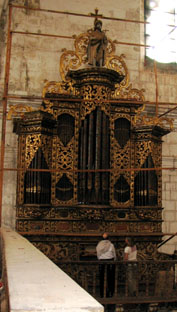
|
|
|
 |
For many years this wonderful organization, under the guidance of its current Director Cicely Winter, has been devoted to the discovery, documentation and restoration where possible of the numerous colonial and post-colonial pipe organs lodged in the churches of Oaxaca, both grand and humble. Almost seventy of these historic instruments have located, in every state of repair, from virtually intact to almost totally ruined. Several, however, have been fully restored, some to playable condition. Recitals on these organs, often after centuries of silence, were the highlights of the festival, which took place over almost a week in mid-March:
March 11
The festival was inaugurated on Friday. March 11, with an evening concert in the majestic precincts of Oaxaca's colonial Cathedral, whose magnificent early 18th century baroque organ stands high in the raised choir at the Cathedral's center. The program of early music, including several works by the 17th century Spanish composer Francisco Correa de Arauxo, was brilliantly performed by renowned Houston organist Robert Bates to an enthusiastic reception by the audience.
March 12
Their musical appetites whetted by the Cathedral recital, an eager audience assembled again the next evening, this time in the city's Santo Domingo Cultural Center, for a concert by the Trio Clerambault. This Franco-Mexican group, playing flute, clavichord and viola da gamba, also specializes in early music. The program featured 18th century pieces by Francois Couperin and J. S. Bach, and was staged in the vaulted main cloister of the former Dominican priory, whose precincts provided an appropriate period atmosphere as well as sonorous acoustics for the talented trio and the appreciative listeners.
|
|
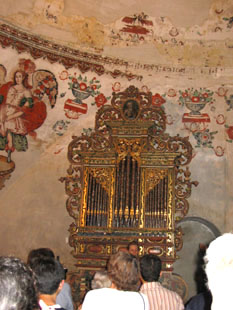 |
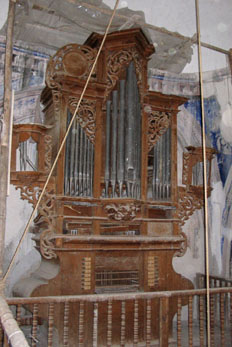
|
The following evening (Sunday), a busload of organ aficionados journeyed to the monastic church of Tlacochahuaya, south of the city of Oaxaca, to enjoy a recital by the distinguished Italian organist and world expert on early organs Luigi Ferdinando Tagliavini. Once again the ambience of this venerable colonial church with its subtly lit painted walls and colorful ceiling murals, proved ideal for the performance of several 17th century pieces by Frescobaldi and Scarlatti among other composers by Maestro Tagliavini on the beautifully restored and tuned pipe organ.
Following the program, the audience was invited up to the choir loft via a winding spiral stairway inside the tower. There the conservator Susan Tattershall explained the details of this outstanding 1730s pipe organ and story of its restoration. Afterwards, we too were restored by refreshments set out in the church forecourt by members of the local community, before driving back to the city.
March 14
Although we were unable to attend the following day's events (Monday): a conference on Girolamo Frescobaldi and Italian Classical Organ Practice led by Signor Tagliavini at Tlacochahuaya followed by a visit to the organ at Huayapan, another treasure filled village church just outside Oaxaca - we were signed up for two other festival events on Tuesday and Wednesday.
|
|
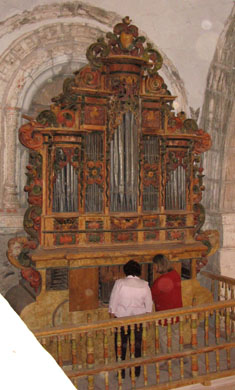 |
On Tuesday a small group of us were treated to a personal tour of Monte Albán, the celebrated ancient "city on a hill" just ouside the city, by Marcus Winter, a leading archaeologist in Oaxaca for many years, who has conducted several excavations at Monte Albán and throughout the state. After our fascinating walk around the temple ruins we visited the elegant museum at the site.
Following our tour of Monte Albán we descended to the nearby Dominican priory of Cuilapan, a vast complex of roofless churches and a vast two story cloister, whose rooms provide a storehouse and laboratory for the numerous archeological investigations carried out by INAH (Instituto Nacional de Arqueologia e Historia) in Oaxaca.
After this eventful day we relaxed at the La Capilla open air restaurant in nearby Zaachila for a delicious lunch of regional specialties.
March 16
Early Wednesday morning, a smaller group of us, hosted by Cicely Winter and including Maestro Tagliavini gathered for an excursion to visit some of the pipe organs in outlying churches north of the city, in the Mixteca Alta region. Our first stop was at the village of Yucucui, where we were welcomed by a committee of local officials eager to show us their colonial church organ, currently awaiting restoration. The old church is ornamented with painted friezes, colonial carvings and several gilded altarpieces also from colonial times.
The villagers accompanied us to our next stop, the magnificent 16th century Dominican priory of Yanhuitlan, still under restoration. Inside the church we ascended to the choir loft, where the ornate early 18th century organ has recently been restored to playing condition. Signor Tagliavini inspected the
|
|
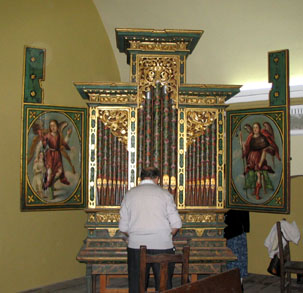 |
From Yanhuitlan it was a short ride along a country road to Santa Maria Tiltepec, an extraordinary church with a sculpted façade facing across a valley from its hilltop site. Once inside the church we all ascended to the raised choir by a winding stairway to view its 18th century pipe organ, standing like that of Yanhuitlan on its own broad pillar beside the choir. Although not yet ready to be played, the organ was resplendant with intricately carved baroque decoration, each of its large pipes painted with masklike faces.
After lunch at a roadside restaurant, we headed back towards Oaxaca city for our last event, a visit to San Andrés Zautla, a small village close to the new Puebla-Oaxaca toll road. The little church here is home to the most beautiful smaller organ that I saw during the festival. Below a carved and gilded crest, ornamental doors painted with archangels open to reveal the by now familiar keyboard, stops and painted pipes. With members of the group energetically pumping the bellows behind the organ - no electronic power here! - Maestro Tagliavini again treated us to a mini concert, obviously delighted with the playing qualities as well as the beauty of this exquisite 1726 instrument. As the villagers prepared the church and its saints for the upcoming Easter celebrations, we reluctantly took our leave and returned to Oaxaca with the sights and especially the sounds of the day still reverberating in our ears and hearts.
Our special thanks to Cicely Winter for her efficiency, thoughtfulness and good humor in organizing this unforgettable week. We plan to return soon for another memorable Organ Festival in Oaxaca.